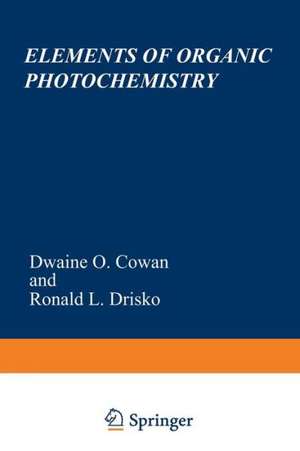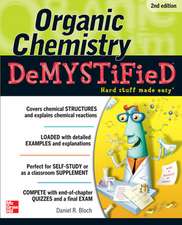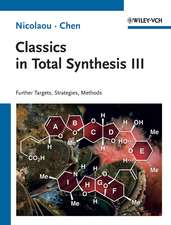Elements of Organic Photochemistry
Editat de D. Cowanen Limba Engleză Paperback – 25 apr 2012
Preț: 643.10 lei
Preț vechi: 756.59 lei
-15% Nou
Puncte Express: 965
Preț estimativ în valută:
123.13€ • 128.22$ • 102.16£
123.13€ • 128.22$ • 102.16£
Carte tipărită la comandă
Livrare economică 13-27 februarie
Preluare comenzi: 021 569.72.76
Specificații
ISBN-13: 9781468421323
ISBN-10: 1468421328
Pagini: 604
Ilustrații: XIV, 586 p.
Dimensiuni: 152 x 229 x 32 mm
Greutate: 0.8 kg
Ediția:Softcover reprint of the original 1st ed. 1976
Editura: Springer Us
Colecția Springer
Locul publicării:New York, NY, United States
ISBN-10: 1468421328
Pagini: 604
Ilustrații: XIV, 586 p.
Dimensiuni: 152 x 229 x 32 mm
Greutate: 0.8 kg
Ediția:Softcover reprint of the original 1st ed. 1976
Editura: Springer Us
Colecția Springer
Locul publicării:New York, NY, United States
Public țintă
ResearchCuprins
1 Basic Photophysical and Photochemical Concepts.- 1.1. Introduction.- 1.2. Energy Distribution in the Excited Molecule.- 1.3. Photochemical Kinetics: Concentrations, Rates, Yields, and Quantum Yields.- 1.4. Classification of Molecular Electronic Transitions and Excited States.- Problems.- 2 Photochemical Techniques and the Photodimerization of Anthracene and Related Compounds.- 2.1. Absorption and Emission Spectra.- 2.2. The Photodimerization of Anthracene and Related Compounds.- 2.3. The Anthracene Triplet State.- Problem.- References.- 3 Photochemical Techniques and the Photochemistry of Ketones.- 3.1. The Photoreduction of Aryl Ketones: Nature of the Excited State.- 3.2. Flash Photolysis.- 3.3. The Photoreduction of Aryl Ketones: Structural Aspects.- 3.4. The Photoreduction of Aryl Ketones: Secondary Reactions.- 3.5. The Photoreduction of Aryl Ketones: Synthetic Applications.- 3.6. The Photoreduction of Alkanones.- 3.7. Intramolecular Hydrogen Abstraction by Ketones (Type II Cleavage).- 3.8. Hydrogen Abstraction by Groups Other Than the Carbonyl.- Problems.- References.- 4 The Photochemistry of Simple Carbonyl Compounds: Type I Cleavage and Oxetane Formation.- 4.1. Type I Cleavage.- 4.2. The Formation of Oxetanes from Carbonyls and Olefins.- Problems.- References.- 5 The Triplet State.- 5.1. Introduction.- 5.2. Determination of Triplet Energy Levels.- 5.3. Determination of the Efficiency of Intersystem Crossing.- 5.4. Determination of Triplet Lifetimes.- 5.5. Excited State Geometry.- 5.6. Spin-Orbit Coupling and Intersystem Crossing.- References.- 6 Electronic Energy Transfer.- 6.1. Excitation Transfer within a Chromophore System.- 6.2. Theory of Excitation Transfer between Two Chromophores.- 6.3. Excitation Transfer between Two Chromophores.- 6.4. Exciplex Quenching.- References.- 7 Dienone and Enone Photochemistry.- 7.1. Dienone Photoreactions.- 7.2. Dienone to Cyclopropyl Ketone Formation.- 7.3. Dienone to Hydroxy Ketone.- 7.4. Cyclopropyl Ketones.- 7.5. 2,4-Cyclohexadienones.- 7.6. Cyclohexenone Photorearrangements.- Problems.- References.- 8 The Di-?-Methane Photorearrangement.- 8.1. Acyclic Di-?-Methane Photorearrangement.- 8.2. Aryl Di-?-Methane Photorearrangement.- 8.3. Bicyclic Di-?-Methane Photorearrangement.- 8.4. Oxa-di-?-Methane Rearrangement.- Problems.- References.- 9 Photochemical Cis-Trans and Valence Isomerization of Olefins.- 9.1. Introduction: Cis-Trans Isomerization of Stilbene.- 9.2. Potential Energy Diagrams.- 9.3. Photosensitized Stilbene Isomerization.- 9.4. Nonvertical Energy Transfer.- 9.5. Stilbene Isomerization via Direct Photolysis.- 9.6. Substituted Stilbenes.- 9.7. Piperylene Photochemistry.- 9.8. Alkene Photoisomerization.- 9.9. Intramolecular Cycloaddition Reactions.- 9.10. Photoelectrocyclic Reactions.- Problems.- References.- 10 Photodimerization and Photocycloaddition Reactions Yielding Cyclobutanes.- 10.1. Photodimerization and Photocycloaddition Reactions of Olefins and Polyenes.- 10.2. Photodimerization and Photocycloaddition Reactions of Aromatic Compounds.- 10.3. Photodimerization and Photocycloaddition Reactions of ?,?-Unsaturated Carbonyls and Acid Derivatives.- 10.4. Dimerization in the Solid Phase.- References.- 11 Photoelimination, Photoaddition, and Photosubstitution.- 11.1. Photoelimination Reactions.- 11.2. Photoaddition Reactions.- 11.3. Photosubstitution Reactions.- References.- 12 An Introduction to Photobiology.- 12.1. Photosynthesis.- 12.2. The Photochemistry of Vision.- 12.3. Phototaxis and Phototropism.- 12.4. Damage and Subsequent Repair by Light(Photoreactivation).- References.








